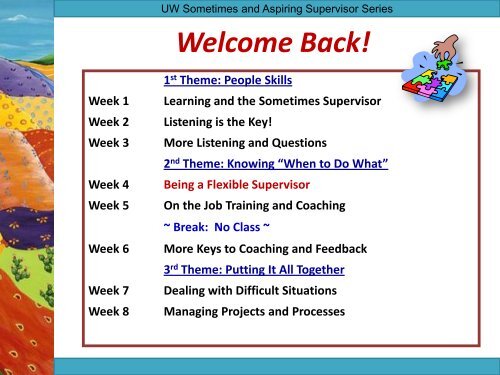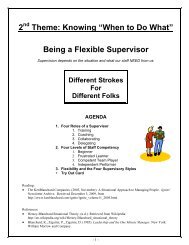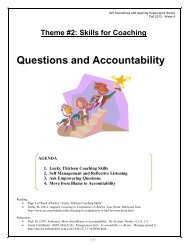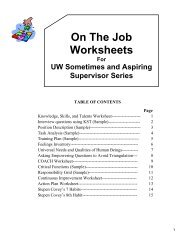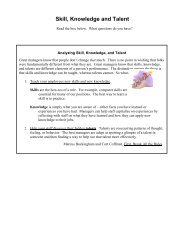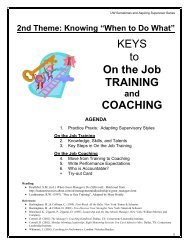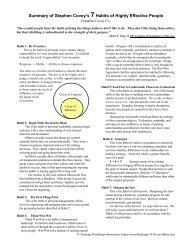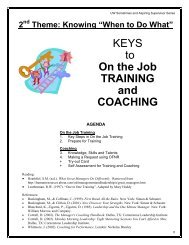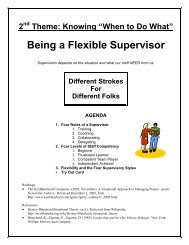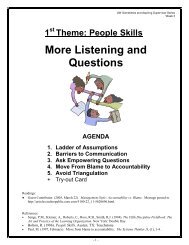Welcome to UW Sometimes and Aspiring Supervisor Series ...
Welcome to UW Sometimes and Aspiring Supervisor Series ...
Welcome to UW Sometimes and Aspiring Supervisor Series ...
You also want an ePaper? Increase the reach of your titles
YUMPU automatically turns print PDFs into web optimized ePapers that Google loves.
<strong>UW</strong> <strong>Sometimes</strong> <strong>and</strong> <strong>Aspiring</strong> <strong>Supervisor</strong> <strong>Series</strong><br />
<strong>Welcome</strong> Back!<br />
Week 1<br />
Week 2<br />
Week 3<br />
Week 4<br />
Week 5<br />
Week 6<br />
Week 7<br />
Week 8<br />
1 st Theme: People Skills<br />
Learning <strong>and</strong> the <strong>Sometimes</strong> <strong>Supervisor</strong><br />
Listening is the Key!<br />
More Listening <strong>and</strong> Questions<br />
2 nd Theme: Knowing “When <strong>to</strong> Do What”<br />
Being a Flexible <strong>Supervisor</strong><br />
On the Job Training <strong>and</strong> Coaching<br />
~ Break: No Class ~<br />
More Keys <strong>to</strong> Coaching <strong>and</strong> Feedback<br />
3 rd Theme: Putting It All Together<br />
Dealing with Difficult Situations<br />
Managing Projects <strong>and</strong> Processes
<strong>UW</strong> <strong>Sometimes</strong> <strong>and</strong> <strong>Aspiring</strong> <strong>Supervisor</strong> <strong>Series</strong><br />
Week 4<br />
2nd Theme: Knowing “When <strong>to</strong> Do What”<br />
Being a Flexible <strong>Supervisor</strong><br />
Different<br />
Strokes<br />
For<br />
Different Folks<br />
Different strokes for the SAME folks in different situations.
<strong>UW</strong> <strong>Sometimes</strong> <strong>and</strong> <strong>Aspiring</strong> <strong>Supervisor</strong> <strong>Series</strong><br />
Week 4<br />
2nd Theme: Knowing “When <strong>to</strong> Do What”<br />
Being a Flexible <strong>Supervisor</strong><br />
Different<br />
Strokes<br />
For<br />
Different Folks<br />
Their<br />
Needs<br />
Different strokes for the SAME folks in different situations.
<strong>UW</strong> <strong>Sometimes</strong> <strong>and</strong> <strong>Aspiring</strong> <strong>Supervisor</strong> <strong>Series</strong><br />
Being a Flexible <strong>Supervisor</strong><br />
AGENDA<br />
1. Self-Assessment<br />
2. Knowledge, Skills <strong>and</strong> Talent<br />
3. Change <strong>Supervisor</strong>y Styles Based on Needs<br />
• Staff Competency<br />
• <strong>Supervisor</strong>y Styles<br />
4. Flexibility <strong>and</strong> the Four <strong>Supervisor</strong>y Styles<br />
+ Try Out Card
<strong>UW</strong> <strong>Sometimes</strong> <strong>and</strong> <strong>Aspiring</strong> <strong>Supervisor</strong> <strong>Series</strong><br />
Being a Flexible <strong>Supervisor</strong><br />
Different<br />
Strokes<br />
For<br />
Different Folks<br />
Individually, think about a great<br />
coach, teacher, or boss.<br />
Write what they did that made them<br />
so effective in box.<br />
Different strokes for the SAME folks in different situations.
<strong>UW</strong> <strong>Sometimes</strong> <strong>and</strong> <strong>Aspiring</strong> <strong>Supervisor</strong> <strong>Series</strong><br />
1. Self-Assessment for<br />
Training <strong>and</strong> Coaching<br />
Individually,<br />
‣ Put yourself in the shoes of your employees (or co-workers)<br />
‣ Rate yourself as your employees would if they were rating you<br />
‣ Select 1 - 4 areas <strong>to</strong> improve<br />
1 My boss gets out of the office <strong>and</strong> spends time<br />
with us.<br />
2 My boss thinks <strong>and</strong> speaks positively.<br />
3 My boss shares information with us.<br />
Rating<br />
Do even<br />
Better
<strong>UW</strong> <strong>Sometimes</strong> <strong>and</strong> <strong>Aspiring</strong> <strong>Supervisor</strong> <strong>Series</strong><br />
You can not teach Talents<br />
Coaching is unlocking people’s potential. It is helping them<br />
<strong>to</strong> learn rather than teaching them. John Whitmore<br />
2. Knowledge, Skills, <strong>and</strong> Talents<br />
Read the box on Knowledge, Skills <strong>and</strong> Talents.<br />
What questions do you have?<br />
• Knowledge: facts or experiences<br />
• Skill: Actions, what we DO with knowledge<br />
• Talent: Natural gifts
<strong>UW</strong> <strong>Sometimes</strong> <strong>and</strong> <strong>Aspiring</strong> <strong>Supervisor</strong> <strong>Series</strong><br />
2. Knowledge, Skills, <strong>and</strong> Talents<br />
continued<br />
• Write some of your Knowledge, Skills, <strong>and</strong> Talents on the chart.<br />
MY Knowledge Skill Talent<br />
<br />
<br />
What new knowledge or skills might help you be an even better<br />
coach?<br />
• Share with a partner. Can you add <strong>to</strong> your partner’s chart?
<strong>UW</strong> <strong>Sometimes</strong> <strong>and</strong> <strong>Aspiring</strong> <strong>Supervisor</strong> <strong>Series</strong><br />
2. Applying Knowledge, Skills <strong>and</strong> Talents <strong>to</strong><br />
Interviewing<br />
The best predic<strong>to</strong>r of future<br />
behavior is past behavior<br />
Behavioral Interviewing:<br />
Step One: Decide what Knowledge, Skills <strong>and</strong> Talents<br />
you are looking for<br />
Mary <strong>and</strong> Shoko’s position:<br />
• Knowledge: Adult education<br />
• Skill: Presentation skills<br />
• Talent: Taking initiative<br />
Step Two: Write a question <strong>to</strong>:<br />
• describe underst<strong>and</strong>ing of knowledge<br />
• demonstrate a skill<br />
• describe a time when he/she demonstrated<br />
a talent<br />
Questions are determined by knowledge, skills or talent.
<strong>UW</strong> <strong>Sometimes</strong> <strong>and</strong> <strong>Aspiring</strong> <strong>Supervisor</strong> <strong>Series</strong><br />
2. Applying Knowledge, Skills <strong>and</strong> Talents <strong>to</strong><br />
Interviewing<br />
The best predic<strong>to</strong>r of future<br />
behavior is past behavior<br />
Behavioral Interviewing:<br />
Step One: Decide what Knowledge, Skills <strong>and</strong> Talents you are<br />
looking for<br />
Step Two: Write a question <strong>to</strong>:<br />
• describe underst<strong>and</strong>ing of knowledge<br />
• demonstrate a skill<br />
• describe a time when he/she demonstrated a talent<br />
Your<br />
Turn<br />
•Knowledge:<br />
•Skill:<br />
•Talent:<br />
Questions are determined by knowledge, skills or talent.
<strong>UW</strong> <strong>Sometimes</strong> <strong>and</strong> <strong>Aspiring</strong> <strong>Supervisor</strong> <strong>Series</strong><br />
2. Knowledge, Skills, Talents<br />
Final Thought<br />
"It is our choices...that show what<br />
we truly are, far more than our<br />
abilities."<br />
Albus Dumbledore<br />
MY Knowledge Skill Talent
<strong>UW</strong> <strong>Sometimes</strong> <strong>and</strong> <strong>Aspiring</strong> <strong>Supervisor</strong> <strong>Series</strong><br />
3. Change <strong>Supervisor</strong>y Styles Based on<br />
Staff Needs<br />
Four Levels of Staff Competency<br />
Frustrated<br />
Learner<br />
Conscious /<br />
Varying levels of Competence<br />
Beginner Conscious / Incompetent<br />
Unaware
<strong>UW</strong> <strong>Sometimes</strong> <strong>and</strong> <strong>Aspiring</strong> <strong>Supervisor</strong> <strong>Series</strong><br />
3. Change <strong>Supervisor</strong>y Styles Based on<br />
Staff Needs<br />
Four Levels of Staff Competency<br />
Independent Performer or<br />
Star Performer<br />
Competent Team<br />
Player<br />
Frustrated<br />
Learner<br />
Conscious /<br />
Habit / Unconscious /<br />
Competent<br />
Varying levels of<br />
Consciousness / Competent<br />
Varying levels of Competence<br />
Beginner Conscious / Incompetent<br />
Unaware
<strong>UW</strong> <strong>Sometimes</strong> <strong>and</strong> <strong>Aspiring</strong> <strong>Supervisor</strong> <strong>Series</strong><br />
3. continued Four <strong>Supervisor</strong>y Styles<br />
The Style supervisor takes depends on NEEDS of:<br />
◦ Employee <strong>and</strong><br />
◦ Situation, including organizational needs<br />
<strong>Supervisor</strong>y style varies by amount of:<br />
Direction: telling what <strong>to</strong> do <strong>and</strong> how <strong>to</strong> do it<br />
Support: using empathy, questioning, recognition<br />
What does employee <strong>and</strong> situation need?
<strong>UW</strong> <strong>Sometimes</strong> <strong>and</strong> <strong>Aspiring</strong> <strong>Supervisor</strong> <strong>Series</strong><br />
Four <strong>Supervisor</strong>y Styles<br />
<strong>Supervisor</strong>y style varies by amount of:<br />
Direction: telling what <strong>to</strong> do <strong>and</strong> how <strong>to</strong> do it<br />
Support: using empathy, questioning, recognition<br />
Competency<br />
of Staff<br />
<strong>Supervisor</strong>’s<br />
role:<br />
Beginner<br />
Training<br />
Clear direction <strong>and</strong><br />
supervision<br />
Low Support
<strong>UW</strong> <strong>Sometimes</strong> <strong>and</strong> <strong>Aspiring</strong> <strong>Supervisor</strong> <strong>Series</strong><br />
Four <strong>Supervisor</strong>y Styles<br />
<strong>Supervisor</strong>y style varies by amount of:<br />
Direction: telling what <strong>to</strong> do <strong>and</strong> how <strong>to</strong> do it<br />
Support: using empathy, questioning, recognition<br />
Competency<br />
of Staff<br />
<strong>Supervisor</strong>’s<br />
role:<br />
Frustrated Learner<br />
Coaching<br />
Direction<br />
Support <strong>and</strong><br />
Encouragement
<strong>UW</strong> <strong>Sometimes</strong> <strong>and</strong> <strong>Aspiring</strong> <strong>Supervisor</strong> <strong>Series</strong><br />
Four <strong>Supervisor</strong>y Styles<br />
<strong>Supervisor</strong>y style varies by amount of:<br />
Direction: telling what <strong>to</strong> do <strong>and</strong> how <strong>to</strong> do it<br />
Support: using empathy, questioning, recognition<br />
Competency<br />
of Staff<br />
<strong>Supervisor</strong>’s<br />
role:<br />
Competent Team Player<br />
Collaborating<br />
Low Direction<br />
High Support<br />
Shared Responsibility
<strong>UW</strong> <strong>Sometimes</strong> <strong>and</strong> <strong>Aspiring</strong> <strong>Supervisor</strong> <strong>Series</strong><br />
Four <strong>Supervisor</strong>y Styles<br />
<strong>Supervisor</strong>y style varies by amount of:<br />
Direction: telling what <strong>to</strong> do <strong>and</strong> how <strong>to</strong> do it<br />
Support: using empathy, questioning, recognition<br />
Competency<br />
of Staff<br />
<strong>Supervisor</strong>’s<br />
role:<br />
Independent Performer<br />
Delegate<br />
Low Direction<br />
Low Support<br />
Evaluate progress,<br />
Recognition
<strong>UW</strong> <strong>Sometimes</strong> <strong>and</strong> <strong>Aspiring</strong> <strong>Supervisor</strong> <strong>Series</strong><br />
Four <strong>Supervisor</strong>y Styles<br />
<strong>Supervisor</strong>y style varies by amount of:<br />
Direction: telling what <strong>to</strong> do <strong>and</strong> how <strong>to</strong> do it<br />
Support: using empathy, questioning, recognition<br />
<strong>Supervisor</strong>’s role in:<br />
Training Coaching Collaborating Delegating<br />
High Direction<br />
High Direction<br />
Low Direction<br />
Low Direction<br />
Low Support<br />
High Support<br />
High Support<br />
Low Support<br />
The goal is <strong>to</strong> move staff <strong>to</strong> both full competency <strong>and</strong> <strong>to</strong><br />
support themselves.
<strong>UW</strong> <strong>Sometimes</strong> <strong>and</strong> <strong>Aspiring</strong> <strong>Supervisor</strong> <strong>Series</strong><br />
Tell trainee about task + Leave<br />
Sea Gull Management<br />
Ken Blanchard<br />
•Leave alone<br />
•ZAP!
<strong>UW</strong> <strong>Sometimes</strong> <strong>and</strong> <strong>Aspiring</strong> <strong>Supervisor</strong> <strong>Series</strong><br />
At Tables, Create a table on your flipchart<br />
like the one in your packet.<br />
Staff Beginner Frustrated<br />
Learner<br />
Feelings<br />
Competent<br />
Team Player<br />
Independent<br />
Performer<br />
Needs<br />
Questions<br />
<strong>Supervisor</strong> Train Coach Collaborate Delegate
<strong>UW</strong> <strong>Sometimes</strong> <strong>and</strong> <strong>Aspiring</strong> <strong>Supervisor</strong> <strong>Series</strong><br />
Use Yellow <strong>and</strong> Red cards <strong>to</strong> fill in boxes on your flipchart.<br />
Staff Beginner<br />
Feelings<br />
Needs<br />
Questions<br />
<strong>Supervisor</strong> Train<br />
Round 1:<br />
Table Completes COLUMN<br />
assigned <strong>to</strong> you<br />
Round 2:<br />
Table Moves 1 Flipchart<br />
Completes next column<br />
Round 3:<br />
Table Moves 1 Flipchart<br />
Completes next column
<strong>UW</strong> <strong>Sometimes</strong> <strong>and</strong> <strong>Aspiring</strong> <strong>Supervisor</strong> <strong>Series</strong><br />
Back <strong>to</strong> your original Tables, What did you<br />
notice about this exercise?<br />
Staff Beginner Frustrated<br />
Learner<br />
Feelings<br />
Competent<br />
Team Player<br />
Independent<br />
Performer<br />
Needs<br />
Questions<br />
<strong>Supervisor</strong> Train Coach Collaborate Delegate
<strong>UW</strong> <strong>Sometimes</strong> <strong>and</strong> <strong>Aspiring</strong> <strong>Supervisor</strong> <strong>Series</strong><br />
3. Change <strong>Supervisor</strong>y Styles continued<br />
In the large group: Analyze this staff meeting<br />
1 Goal of<br />
meeting<br />
2 Website<br />
update<br />
3 Database<br />
Edit<br />
SASS Facilita<strong>to</strong>rs' Meeting<br />
Agenda<br />
Update SASS website<br />
Edit info in database<br />
Learner Needs
<strong>UW</strong> <strong>Sometimes</strong> <strong>and</strong> <strong>Aspiring</strong> <strong>Supervisor</strong> <strong>Series</strong><br />
4. Flexibility <strong>and</strong> Four <strong>Supervisor</strong>y Styles<br />
At your tables,<br />
1. Pick ONE real situation <strong>to</strong> diagnose. <strong>Supervisor</strong> fills<br />
in some or all of boxes below.<br />
2. Table members ask only open-ended questions.<br />
3. All table members collaborate <strong>to</strong> name the learner’s<br />
needs.<br />
4. Determine what the supervisor has done so far.<br />
5. Suggest a few strategies that supervisor might try.<br />
<strong>Supervisor</strong> Train Coach Collaborate Delegate<br />
Employee<br />
Beginner Frustrated<br />
Learner<br />
Competent<br />
Team Player<br />
Independent<br />
Performer
<strong>UW</strong> <strong>Sometimes</strong> <strong>and</strong> <strong>Aspiring</strong> <strong>Supervisor</strong> <strong>Series</strong><br />
+ TRY-OUT CARD:<br />
APPLICATION TO WORKPLACE<br />
• What skills would you like <strong>to</strong> practice this week?<br />
• Review Self-Assessment for Training <strong>and</strong><br />
Coaching<br />
• Bring back <strong>to</strong> class<br />
Next Week:<br />
2 nd Skill: When <strong>to</strong> Do What<br />
On The Job Training <strong>and</strong> Coaching


